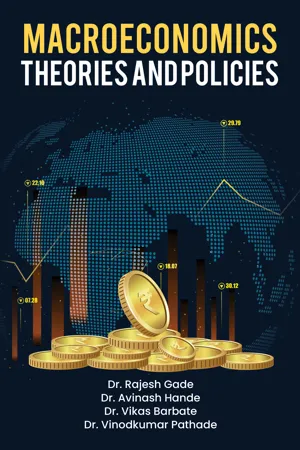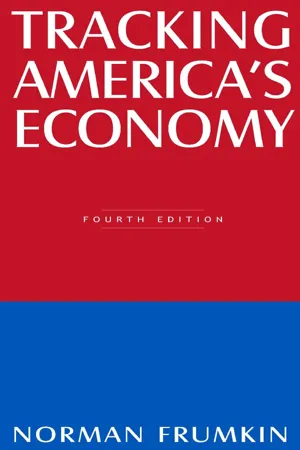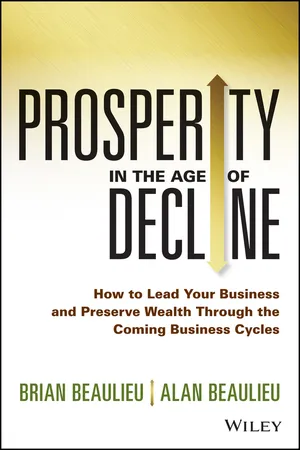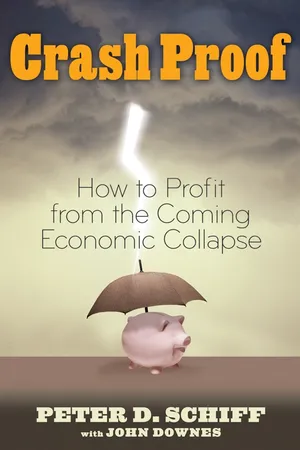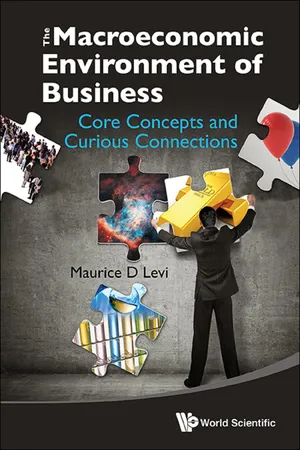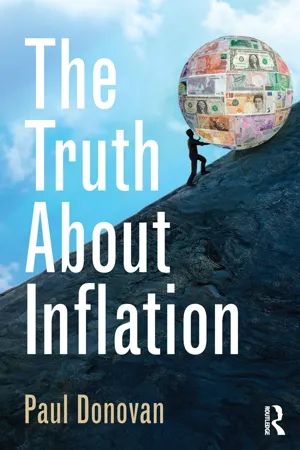Business
Inflation and Business
Inflation refers to the general increase in prices of goods and services in an economy over a period of time. In the context of business, inflation can impact costs, pricing strategies, and consumer purchasing power. Businesses may need to adjust their pricing, wages, and investment decisions to mitigate the effects of inflation on their operations and profitability.
Written by Perlego with AI-assistance
Related key terms
9 Key excerpts on "Inflation and Business"
- No longer available |Learn more
Macroeconomics
Theories and Policies
- Dr Rajesh Gade, Dr Avinash Hande, Dr Vikas Barbate, Prof. Vinodkumar Pathade(Authors)
- 2023(Publication Date)
- Blue Rose Publishers(Publisher)
Inflation and Money 7.1. IntroductionMonetary inflation is a persistent increase in a country's money supply. Price inflation, which is often the result, refers to an increase in the average level of products and service costs. The term “inflation” was first largely used to refer to monetary inflation; nowadays, it is more usually used to refer to price inflation.Changes in the economy's money supply and demand are mostly brought about by inflation. Over time, rising prices for goods and services is referred to as inflation. There will be an excess of money chasing a constrained supply of goods and services, which will result in higher prices, if the quantity of money in an economy grows faster than the rise in production. Because customers have more money to spend, inflation is driven by demand, and businesses can raise prices to satisfy this demand.A decline in the supply of products and services in comparison to demand can cause inflation, which results in increased prices. For instance, if a natural catastrophe or supply shock restricts the availability of a key commodity, the price of that commodity and the products and services that depend on it may increase.To regulate the money supply and lower inflation, central banks employ monetary policy tools include modifying interest rates, reserve requirements, and open market operations. The central bank can lower the quantity of money in circulation and control demand-driven inflation by raising interest rates. As an alternative, the central bank can boost economic activity and expand the money supply to boost demand and counteract supply-driven inflation.A crucial indication of economic development, income equality, and social wellbeing is inflation. High and unpredictably fluctuating inflation can diminish people's and companies' purchasing power, discourage investment, and sow economic instability. In an inflationary environment, central banks and decision-makers must carefully control the money supply in the economy to preserve price stability and advance sustainable economic growth. - eBook - ePub
- Norman Frumkin(Author)
- 2015(Publication Date)
- Routledge(Publisher)
assets .DEFINITIONS
Inflation is the general term given to a rise in overall prices for the total of all goods and services in the economy on an ongoing monthly, quarterly, and annual basis. Deflation represents a decline in overall prices of goods and services. Zero inflation occurs when there is no change in overall prices. It results from offsetting price increases and decreases among the individual items.There are varying inflationary gradations that both affect and are affected by the economy quite differently. Examples of these gradations are: core inflation, accelerating inflation vs. disinflation, creeping inflation vs. hyperinflation, and tolerable inflation.Core inflation is an objective measure of price change that excludes changes in energy and food prices. It is sometimes called the “underlying rate of inflation” because it abstracts from temporary price fluctuations in food and energy that may have nothing to do with long-term price pressures in the economy. Food prices fluctuate in large part due to changes in the weather associated with rainfall and frosts, as well as with natural disasters of floods and hurricanes. These physical elements directly affect plantings and harvests of grains, fruits, and vegetables, which in tum affect cattle prices through feed grain prices, with larger harvests tending to lower prices and smaller harvests tending to raise prices. Energy prices fluctuate as the discipline of member nations in maintaining cartel prices among the Organization of Petroleum Exporting Countries (OPEC) strengthens and weakens. When the nations tend to regulate their oil production in line with OPEC guidelines, the effect is to bolster prices, and when they do not follow the production guidelines, the effect is to weaken prices. Daniel Yergin illuminates the political problems of maintaining discipline among the OPEC nations in adhering to agreed-on country output quotas.1 - eBook - ePub
Trading Economics
A Guide to Economic Statistics for Practitioners and Students
- Trevor Williams, Victoria Turton(Authors)
- 2014(Publication Date)
- Wiley(Publisher)
4 InflationInflation is always and everywhere a monetary phenomenon in the sense that it is and can be produced only by a more rapid increase in the quantity of money than in output.Milton Friedman1WHAT IS INFLATION?
Inflation tells us the changing (increasing) price of a range of goods or services; basically how much of something we can get for our money. The rate of change of prices – the speed at which the price of goods and services that are bought by households or businesses alter – is called inflation. But prices can also fall, in a process called deflation, sometimes termed negative inflation. Inflation is more common than deflation, or at least it has been in the last 50 years or so, and so it has become associated with changes in the price of goods and services. Historically, however, price falls were as common as price rises, as we will see later.Both inflation and deflation have advantages and disadvantages, which we will explore in more detail later in this chapter.THE HISTORY OF INFLATION
Inflation has been around for a long time, but, as Figure 4.1 shows, the level of prices (the index) really only rose consistently and sharply in the UK from the 1970s onwards. This was after the US came off the gold standards and the Bretton Woods system of fixed exchange rates, which had prevailed after the Second World War, ended. Money was now backed by government fiat and trust rather than by gold. And exchange rates were no longer fixed but allowed to float freely. This seems to have led to a rapid rise in the level of prices or, in other words, to the Retail Prices Index. Before that, for hundreds of years, the level of the index barely changed, as periods when it was rising were matched by periods when it was falling.Figure 4.2Figure 4.1Price index over time.Source: ONS. - eBook - ePub
Prosperity in The Age of Decline
How to Lead Your Business and Preserve Wealth Through the Coming Business Cycles
- Brian Beaulieu, Alan Beaulieu(Authors)
- 2014(Publication Date)
- Wiley(Publisher)
Inflation comes in several forms and stems from numerous causes. There is asset price inflation, which is most easily identified with loose monetary policy. Think of the U.S. housing bubble of 2006 and the global bubble in stock prices in the latter half of the 1990s, 2003 through 2007, and 2010 through 2013. There is also run-of-the-mill price inflation, which can come because of labor prices increasing. It may start with commodity prices rising, consumer expectations of higher prices, or government policies. For example, as we write this, the government of Japan is trying to reignite inflation, and the United States is maintaining a course of action that clearly fears deflation and high unemployment more than future inflation. Europe is seeing no serious signs of inflation as it struggles to rebound from the financial issues of 2008. China has no clear picture of inflation that it shares with the rest of the world. India is contending with inflation of 10.7 percent in late 2013 while its economy struggles to grow. Although we are clearly a global economy, the preceding shows that there are competing sovereign interests at work that make a globally coherent policy about inflation impossible to achieve and adhere to. In the end, the larger economies will hold sway over the smaller ones. For better or worse, the United States' propensity to inflating its economy is going to bring inflationary pressures to bear on other countries.Inflation is rather straightforward from a business perspective: costs are going up. It could be materials, labor, power, taxes, or social costs, but something is escalating the cost of producing the good or service one is in business to produce. This type of inflation is arguably the most painful in the long term. It also happens to be the one with which people today are least familiar. This isn't the short-run inflation Japan has in mind when it tries to stimulate some domestic demand; rather, it is what happens after an initial surge in inflation occurs and the spiral catches hold. Then, a broader follow-on inflation replaces the initial pulse of higher prices.This broader inflation is not simply that business costs are going up; consumer prices are also rising. What makes the inflation tendency so problematic is that a very vicious self-perpetuating spiral develops. Because consumers must pay more, we demand more in the form of wages to compensate. We also want to buy what we want now, before prices go even higher. Because of this pressure—and particularly in places such as the United States that have a shortage of skilled labor—wages go up. This of course drives business costs even higher. Now, because expectations - eBook - ePub
Leading Through Inflation
And Recession and Stagflation
- Ram Charan, Geri Willigan(Authors)
- 2022(Publication Date)
- Ideapress Publishing(Publisher)
Inflation Is Everybody’s Business: Your RoleArmed with a general understanding of how inflation affects a business, you are better prepared to help your company succeed despite it. But that is not enough. Every business function has a role to play in coping with inflation and preparing for what will follow. Actions you take now will not only mitigate the damage from inflation but also strengthen the company so it will be well positioned when the economy takes a turn for the better. This chapter is a series of short sections to help you zero in on how your particular job or function can make a material difference:- For the CEO
- For the CFO and Finance
- For Sales and Marketing
- For Operations
- For Procurement
- For the CIO and IT Department
- For Research and Development
- For Public Relations and Investor Relations
- For Human Resources
- For the Board
FOR THE CEO
A CEO has two broad mandates: leader of the business and leader of its people. Of course they are intertwined, but under inflation, recession, or stagflation, neglecting either one of these responsibilities is high risk. If you’re not a CEO but lead a business unit or division, many of these lessons will also apply to you.As trustee of the business, the CEO has four critical areas to focus on:- 1. Cash coming in, going out, and its timing. Chapter three explained why working capital, capital expenditures, and debt are so touchy now; they are the cause of many company failures in earlier periods of high inflation. The CEO should work with the CFO to set up alerts and do planning on a cash basis. Every major financial decision must be viewed through the lens of cash.
- 2. Pricing, and making it happen. It is a specialized expertise that requires analytics, but it cannot be fully delegated. The CEO must understand the basic choices in philosophy and tactics to ensure that the company is doing well for both itself and its customers. He or she will have to be hands-on with sales and marketing to be sure they are moving fast and smart on pricing. It may be necessary to reassign some leaders if they are unable to implement price changes. The company simply can’t afford to wait for leaders to catch up. To protect real profitability, you’ll need to revisit key contracts and change those that lock you into a situation that could lead to a cash shortage. As CEO
- eBook - ePub
Crash Proof
How to Profit From the Coming Economic Collapse
- Peter D. Schiff, John Downes(Authors)
- 2010(Publication Date)
- Wiley(Publisher)
Consumer price index, year-over-year change, 1997-2006. Even the government’s own highly flawed and greatly manipulated index revealed inflation was accelerating even as the government and Wall Street claimed that it was well contained. By the time the problem was partially acknowledged, the government’s response was too little and too late.Source: Reprinted by permission from David L. Tice and Associates (www.prudentbear.com ).WHAT INFLATION IS AND ISN’T
Inflation means expansion, in the same sense that a balloon expands when you blow air into it. In economics, inflation refers to expansion of the amount of dollars in circulation, called the money supply. When new money or credit is added to an economy, thus diluting the existing supply, the general level of prices (aggregate prices) will rise, assuming the amount of goods and services within the system stays the same. But understand the distinction: The money supply expands and contracts. Prices go up and down. Inflation and price increases are not the same thing. One is cause. The other is effect.The reason that expansion of the money supply causes aggregate prices to rise is simple. As the supply of dollars grows relative to the supply of goods, more dollars are needed to buy a given quantity of goods. In other words, the dollar’s value is diminished relative to the goods available for sale. It’s basic supply, represented by sellers, and demand, represented by buyers. Any kid who collects baseball cards understands it. The more a particular card is in circulation, the less it is worth. The value of a card is a function of its scarcity. The more abundant the supply, the less something is worth. The same holds true for money.HOW INFLATION CREATES ARTIFICIAL DEMAND
So inflation is monetary expansion or, in other words, more money chasing a constant or diminishing supply of goods and services. It doesn’t have to be physical dollars added to the supply of money. It can just as well be expanded credit. Anything that artificially increases aggregate demand for goods and services is inflation. Printing money - eBook - ePub
- Samih Atef El-Zeyn(Author)
- 2019(Publication Date)
- Routledge(Publisher)
Chapter Thirty-FourFinancial Inflation
(p. 297) In its linguistic meaning in Arabic, inflation (tadflkhkhum ) refers to immensity and increase in size. The verb from this noun ((Lakhuma ), means to become larger in size. There is another verbal derivation (dakhkhama ), which means ‘to cause to increase in size’. The adjective from the same root (dakhkham ),135 indicates the version of greater magnitude of anything.In the financial sense, which is the one intended here, the term ‘inflation’ has a conventional meaning:Inflation is the continuous increase in prices which results from the increase in the demand for cash and the increase in the actual supply of goods and services. Such increase is attributed to the particular nature of the internal structure of production, the distribution and degree of monopoly and centralization, the extent of dependence on foreign countries and the impact of the prices of imports.136What needs to be clarified is the difference between financial inflation and cash inflation, the latter being manifested in the pumping of huge surplus amounts of paper money into the market. The circulation of this money leads to a decrease of the purchasing power of the currency unit of a given country. Financial inflation, on the other hand, is the increase in the various economic capitals, particularly those which constitute goods or merchandise or those which form non-material capital, such as investment rights, copyrights, patents and other things that can have a monetary value regardless of its denomination, (p. 298) To these may be added the inflation in manpower and various types of production materials.According to this differentiation, money is the tool used for assessing the value of the various exchange elements, to the extent that the amount of money used will reflect the real value of the exchanged products, which ultimately reflects the human effort exerted in their production. Thus, the concept of money will be linked to the concept of merchandise, and money will thus be considered as merchandise. - eBook - ePub
The Macroeconomic Environment of Business
Core Concepts and Curious Connections
- Maurice D Levi(Author)
- 2014(Publication Date)
- WSPC(Publisher)
Figure 4.1 which describes U.S. inflation history over almost a century—shows that inflation—a rising price level—is far more frequent than deflation—a declining price level—although there have been occasions, such as during the Great Depression, 1929–1933, when prices fell sharply.Fig.4.1. Almost a century of U.S. inflation and deflation.Source: United States Bureau of Labor http://en.wikipedia.org/wiki/File:US_Historical_ Inflation.svg .Inflation rates can differ greatly between countries and within countries over time.In this chapter we explain possible causes of inflation. We also consider the effects of inflation and the importance of how accurately inflation is forecasted by savers, workers and others. As we shall see in later chapters, unanticipated inflation is in many ways more important than the rate of inflation itself, having an important bearing on other macroeconomic phenomena, including unemployment, GDP and interest rates. This is why we set out to deal with as many aspects of inflation as we can, all in one chapter; later chapters can then build on these foundations. However, before dealing with the causes and effects of inflation it is useful to consider how it is measured, and the accuracy of the alternative measures that are used. We shall see that as with most important macroeconomic variables, published inflation statistics are only estimates, requiring some care in interpretation.1MEASURING INFLATIONAs we are all well aware, inflation reduces the buying power of any given dollar amount of income or savings. The rate of inflation is measured by the rate at which an index of prices goes up (or goes down in the case of deflation). The price index - eBook - ePub
- Paul Donovan(Author)
- 2015(Publication Date)
- Routledge(Publisher)
10 Inflation and the modern investorWith our inmost feelings we despise that low, yet pernicious trick, of some Journalists, who, however difficult, however complex a subject may be, however it may have divided the opinions of the wisest and best informed men, still address the mass of their readers on it, as if it were ‘as plain as a pike-staff’.(Samuel Coleridge, Essays on His Times in the Morning Post and Courier )As was hopefully made clear from the outset, the aim of this book has been to explain inflation and not to predict inflation. There is no point an economist trying to publish a book that offers predictions on the future course of inflation for a global audience – it would be out of date before it reached the bookshelf or the e-book reader. Inflation is going to vary from country to country. Inflation is going to vary from age group to age group. Inflation is going to vary from income group to income group. Inflation is one thing for a company, another for a consumer, and something else entirely for a borrower. Inflation will depend on wildly different economic circumstances, and it will ebb and flow over time. Confronted by this kaleidoscope of inflation possibilities, no investor should put blind faith in simple predictive models of a single variable like the consumer price index as being the answer to all inflation concerns. What is of most use to investors is trying to understand the complexity of inflation, to better inform their own opinions in their own time and place.What this book has hopefully demonstrated is that inflation is a recurrent feature of the global economy. The second chapter showed that human civilisation has been littered with inflation from at least Ancient Byzantium onwards. The remarkable history of those medieval Chinese dynasties, falling like dominoes one after another in the wake of an endless loop of excess money printing and rising inflation, demonstrates that governments are not necessarily terribly adept at learning the lessons of history. Whatever the outlook for inflation in the near term, inflation will be a feature at some point in the future, somewhere in the world, for at least a certain subsection of an economy.
Index pages curate the most relevant extracts from our library of academic textbooks. They’ve been created using an in-house natural language model (NLM), each adding context and meaning to key research topics.
